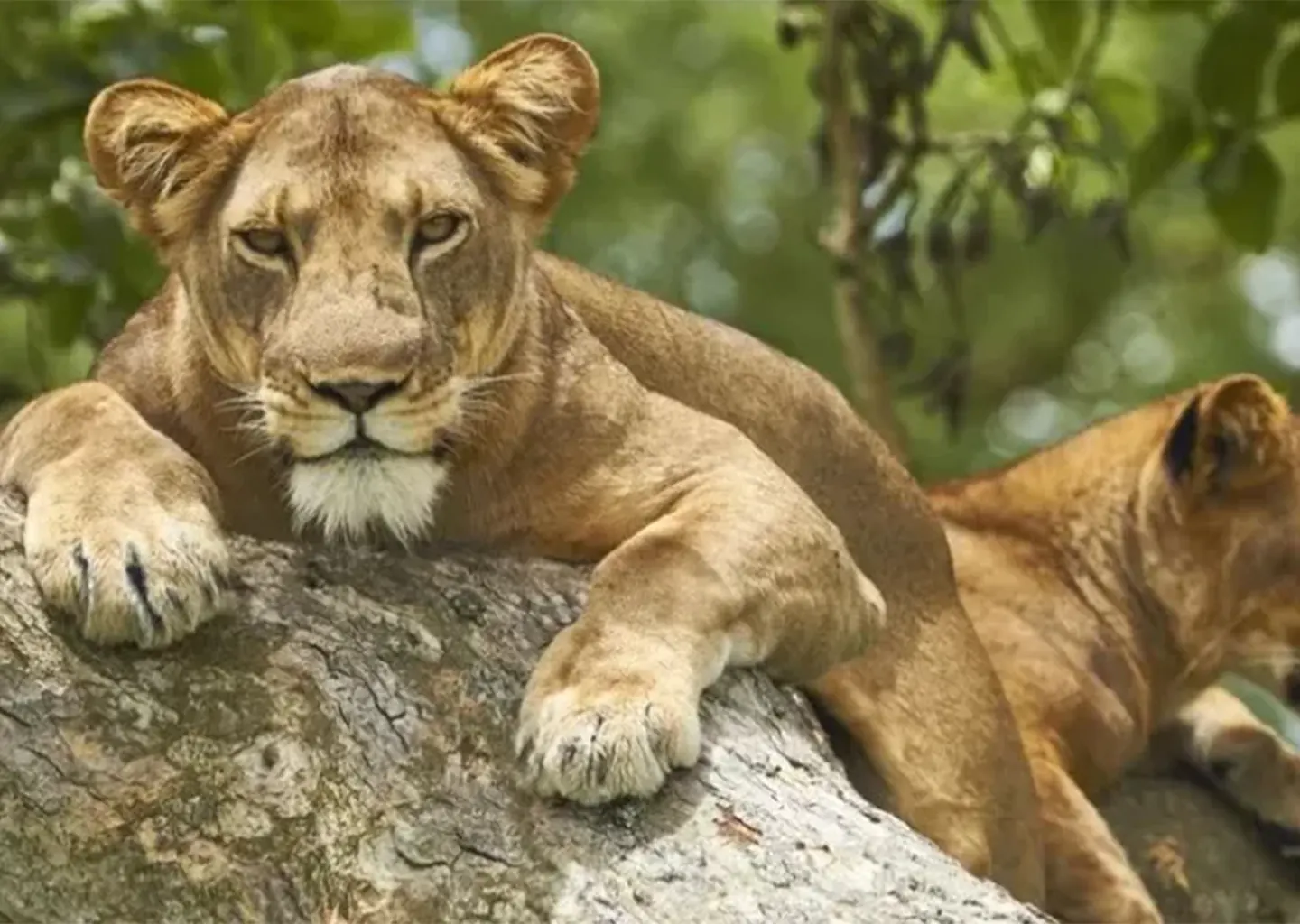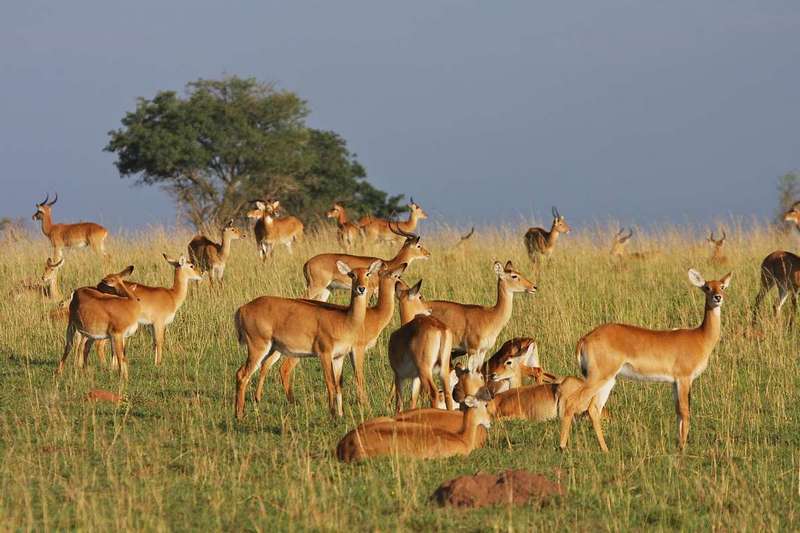Queen Elizabeth National Park
Queen Elizabeth National park was gazeted in 1952 as Kazinga National park and later in 1954 the park was renamed Queen Elizabeth as a commemoration of the British monarchy visit. Before in 1920’s the park existed as lake Edward and George game Reserves.
Queen Elizabeth National park is one of the most popular National parks and since the park is rich in the eco system made up of the open savannah grassland, forests, lakes and fertile soils Queen Elizabeth therefore is a home to over 600 bird species, 10 primate species, 95 mammals including the big five and 20 of them are carnivores like Leopards, the park has 10 crater lakes and its popular for the tree climbing lions. Queen Elizabeth National park has a tropical kind of climate and its nearness to the equator makes it have a warm temperature remaining uniform through out the year. The temperature during day time is around 29degrees Celsius or 84degrees Fahrenheit and slowly drops to around 17degrees Celsius or 63degrees Fahrenheit therefore in Queen Elizabeth its expected to rain anytime.
Attractions in Queen Elizabeth National Park

Queen Elizabeth national park is gifted with many attractions that lure tourists to visit the park and the following are some of them;
Tree Climbing lions. There are two populations of the tree climbing lions in the world those found in Uganda in the Queen Elizabeth in the southern part and those found in the southern part of Tanzania in lake Manyara National park. Since the lions are not meant to be climbing this is attracts many tourists to go and watch how these lions climb the trees. The tree climbing lions are the star attraction in Queen Elizabeth National park and these are found in the Ishasha sector of the park seen in the fig trees and Acacia trees.
Kazinga channel. This is a natural wide 32km water channel which connects the two lakes of George and Edward in the south western part of Uganda and is found in Queen Elizabeth. Kazinga channel is a home to many hippopotamuses, buffaloes, crocodiles and elephants which can be observed while on Kazinga boat ride.
Kasenyi plains which is a home to many wildlife and its oftenly visited by tourists on wildlife safaris. It is a home to good number of antelopes, Uganda Kob, lions and other several predators.
Mweya peninsular. This is a piece of land that extends into lake Edward. Mweya peninsular us a chunky grass cover with dense vegetation dominated by Candelabra and thorny bushes. The activities that can be carried out in Mweya peninsular include game viewing, boat cruising on Kazinga channel where bookings can be made at Mweya Uganda Wildlife Authority offices, mongoose tracking which is done on foot with a professional guide and it’s a three hours activity through the trails. This involves watching and learning about the behaviors of the rodents, Community tours or walks which involves visiting the communities and interaction between the locals. Mweya peninsular gives a splendid views of mountain Rwenzori and It is a perfect place to spot leopards from and is a focal point for the beauty in the Northern part of the park.
Lake Katwe and Katwe salt works This is one of the lakes found in Queen Elizabeth national park located in the North of Mweya peninsular and they have the highest elevation of within the park. During the drive or boat cruise on the lake you can observe the Great Western Rift Valley and the escarpments, other scenic views of Lake George, Mountain Rwenzori ranges, Kazinga channel which connects lake Edward and Lake George. Lake Katwe is also known for the salt mines which are being carried therefore It is a source of the rock salt. Salt mining is the major activity that is being carried out on lake Katwe. Tourists visit Lake Katwe to see how salt is being mined using the traditional methods and also see the lake.
Kyambura wildlife Reserve. This is one the known areas in Queen Elizabeth National park with panoramic views of the wildlife, primates, butterflies, birds and the vegetation. This area is bordered by Kyambura Gorge in the West, Kyambura wildlife reserve is situated in the North Eastern part of the park and also links to the Kazinga channel forming the Northern boundary villages and village plantations lie in the Southern end of the reserve.
Kalinzu forest. This forest is located in the South Eastern edge of Queen Elizabeth and one of the popular destination one shouldn’t miss to visit. Kalinzu forest offers better chimpanzee tracking experiences.
Primates in Queen Elizabeth National Park.
Since the park has 10 primate species that are harbored therefore primates are one of the attractions in the park one cant miss viewing in the diverse habitants with chimpanzees being the most popular however other endangered species are found in the Kyambura Gorge and others can be seen in the forested areas o Queen Elizabeth like the Maramagambo forest, Kyambura Wildlife Reserve. Primates like White and black colobus monkeys, Vervets, Red tailed monkeys, Pottos, bush babies, Blue monkeys, L’Hoests monkeys, Baboons will be seen.
Maramagambo forest. This covers the part of Queen Elizabeth national park from the escarpment of Kichwamba and through Lake Edward. This forest is good for tourist activities like hiking, forest nature walks, primates watching a tracking, birding. Maramagambo forest is found within the southern part of Queen Elizabeth National park and Its famous for the bat caves. The forest is bordered by two crater lakes of Lake Kyasanduka and lake Nyamasingiri. Maramagambo forest ha animals like chimpanzees, bêtes pygmy antelopes, blue monkeys among others, birds like white napped pigeons, flycatchers, Rwenzori Turaco among others.
Kyambura Gorge. Is a magnificent valley of apes in Queen Elizabeth National park situated in the Eastern part of the park and is shared by River Kyambura. Kyambura Gorge is a habitant for chimpanzees and also other wildlife, birds like greater flamingoes, Papyri gonolek, African Skimmer, Papyrus canary, White tailed lark, Vereux eagle, owl lesser among others, primates like Olive baboons, Red tailed monkeys among others.
Lake George. Lake George is found near Queen Elizabeth National park and situated in the Western part of the Great East African Rift Valley covering 250 square kilometers. Lake George is supplies by a variety of water bodies and is a habitant to many wildlife an birds.
Lake Edward. Lake Edward is located in the western branch o the East African Rift Valley lying on the border of DRC and Uganda covering a surface area o 2325 square kilometers and is one of the water bodies in the park which supplements on the beauty of Queen Elizabeth National park. Boat riding can be done and during the rides on lake Edward you will get spectacular views of the Mountain Rwenzori, Queen Elizabeth National park. Lake Edward is a habitant to animals like buffaloes, Elephants, Crocodiles, hippos and a number of birds can be seen.
Accommodational Facilities in Queen Elizabeth National Park
The Batwa also called the pygmies are said to be the last group of short people also known as the Twa. Their physical structure and cultural heritage of the Batwa has become a hot spot for most visitors who uAVndertake safaris in Uganda. Originally, the Batwa live in Bwindi Impenetrable forest national park where they survived as hunters and food gatherers but after the establishment of Bwindi National park, the park authority evicted the Batwa from the forest for purposes of conserving the rare mountain gorillas which were almost facing extinction and now they flourish on the communities around Bwindi forest national park but not in the forest itself.
The Batwa considered themselves as the keepers of the forest, they hunt small game using arrows and bows. They would also harvest honey, gather wild roots and wild fruits. They would use climbing plants and tree leaves to build their houses.
After the eviction of the Batwa, some personalities and non-government organizations came up to help them improve their lives. They built for them schools, good houses and hospital to support their lives.

How to get to Bwindi Impenetrable Forest.
Queen Elizabeth can be visited any time all year around. Tourism had two season that is the peak season and low season. The peak season is when the tourism is being carried out at a high rate that is we expect the crowds in the park since there are many tourists and the low season is when a few tourists come to visit thus less crowds in the park. There fore since the park receives tropical type of climate we are going to look in to the two different seasons that is the dry season and the wet season. Dry season this is when the park doesn’t receive rainfall. But since its not guaranteed that it won’t rain she it does during the dry season its normally very little rainfall received therefore the roads and pathways in the park will be dry the easy and simple to be accessed, vegetation will be short and getting clear observations of the attractions and photographs. The dry season normally runs from the month of December, January, February, June, July being the most dry, August and September and these months are regarded as the high or peak season. The dry season has the most favorable conditions.
Wet season. This is when the park is either receiving long or heavy rains and the short rains. Therefore this means that its raining almost everyday in the park and this attracts much coldness in the park, wet, muddy, slippery and slick roads thus making it difficult to access the park. Since its raining the soils will be fertile leading to the over growth of vegetation hindering accessibility of the park and also un clear photographs due to the fog and the over grown shrubs distracting the attractions. The wet season is also considered as the low season and this takes months of March, April, May these receive short rains an October and November which receive the heavy rains. Therefore the best time and favorable time to visit Queen Elizabeth is during the dry season since it has easier and favorable conditions. As earlier said the dry season is just the perfect time to visit the park its not limited to it. One can choose to visit Queen Elizabeth any time he wished to.


